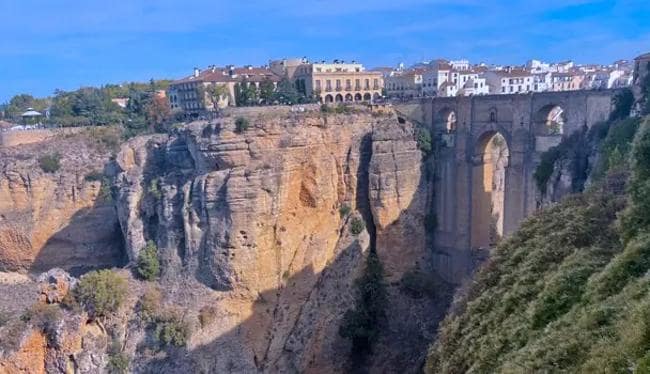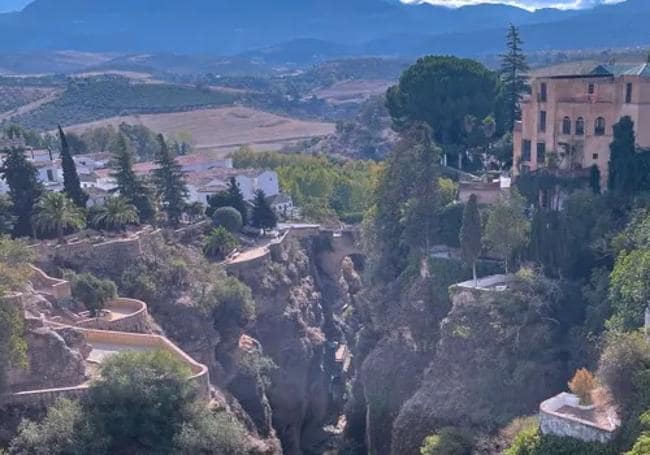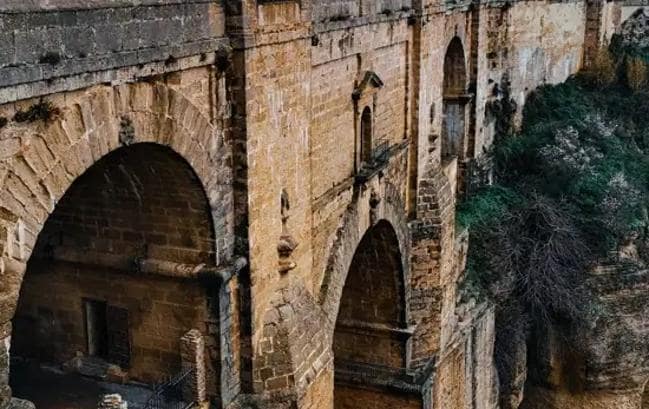

Sections
Highlight

Rocío Jiménez
Ronda
Tuesday, 14 November 2023
After climbing a winding mountain road from the Costa del Sol, accompanied by a stunning view of nature, Ronda appears before your eyes, one of the oldest towns in Spain with a wealth of monuments and a legacy from different civilisations that captivates and amazes visitors.
The land of bandits and a source of inspiration for some famous artists, Ronda has a peculiar natural feature marked by the Tajo, a gorge carved out by the Guadalevín river. It stretches some 500 metres and is 100 metres deep, dividing the town in two. Beyond the bullring (the oldest in Spain), the Arab baths, the Mondragón Palace, and the Church of Santa María la Mayor, you will find the Puente Nuevo ('New Bridge'), its most iconic monument and one of the most beautiful in the whole Malaga province.

This monumental construction joined the new town, the 'mercadiilo', with the old town, allowing the municipality to expand naturally across the gorge. The bridge offers visitors sunsets fit for postcards that remain engrained in your mind, but it must be said that it is not for those who are afraid of heights.
Ronda has three bridges: the San Miguel bridge, located 12 metres above the river and built from stone slabs in the thirteenth century. Next is the Viejo 'old' bridge that, with a height of 31 metres and a single arch of 10 metres, was built in the sixteenth century to connect the old Islamic neighbourhood with the new one that emerged after the conquest in the Mercadillo area. And finally, the New Bridge, which is the highest of the three and had to be built twice.
This impressive piece of engineering was first proposed in 1735, during the reign of Felipe V. The plan then was for a structure 100 metres tall and a single arch with a span of 35 metres. A plan that only took eight months to complete, a record for the time. However, the bridge collapsed six years later taking the lives of 50 people as hundreds of tons of stone fell down the gorge. This was likely due to the project being rushed, leading to a poor execution and a lack of support for the arch. As the saying goes, slow and steady wins the race.

Despite this tragic turn of events, another plan was created to rebuild the bridge, this time 98 metres tall and of a more solid structure. This project was led by José Martín de Aldehuela (who is also responsible for building the bullring in Ronda), with the help of a stonemason born in the municipality, Juan Antonio Díaz Machuca, who devised devices to help the old stone fall down safely. Works on the new bridge began in 1751 and continued until 1793, coinciding with celebrations during the Real Feria de Ronda, the oldest festival in Andalucía.
The foundations of this version of the bridge go all the way down to the bottom of the gorge, and it has three segments formed by semicircular arches. The lower one acts as a brace, while the second one, at 90 metres in height, is surrounded on its flanks by two buttresses, where the arches in the upper segment start. The stone used to build it was extracted from the bottom of the bottom of the gorge, creating an authentic imitation of the original construction.

The Cuenca gardens (Jardines de Cuenca), located at different elevations facing the bridge, give some of the best views and let you appreciate the magnitude of the bridge.
The New Bridge was declared a Natural Monument in Andalucía in April 2019.
To give you an idea of its size, the depth of the gorge below the bridge is equivalent to a 30-storey building.
Legend has it that José Martín de Aldahuela committed suicide by jumping off the bridge because he could not conceive a bridge more beautiful than this one. His remains rest under Plaza del Convento in San Pedro de Alcántara.
Over the main arch, in the interior of the bridge, you can see a small window that was once a room. It was actually a prison for dangerous criminals, an inn, and today, a visitor centre.

When it is very windy, it produces loud whistles under the bridge. Also, the gusts can lift water out the river, leading locals to say it "rains upwards".
The best views of the bridge can be had from the end of a small path that runs from the Plaza de María Auxiliadora.
The viewpoint near the New Bridge, on the paseo de la Alameda, is known as 'balcón del coño' (a bad word in Spanish!) due to the feelings it gives you when you stand there.
This bridge was the tallest in the world from its construction in 1793 until 1839, the year when the Caille bridge in France took its place.
It is also the perfect place to go birdwatching and see birds flying above the gorge, as well as bird nests from peregrine falcons or alpine choughs.
Publicidad
Publicidad
Publicidad
Publicidad
Esta funcionalidad es exclusiva para registrados.
Reporta un error en esta noticia

Debido a un error no hemos podido dar de alta tu suscripción.
Por favor, ponte en contacto con Atención al Cliente.

¡Bienvenido a SURINENGLISH!

Tu suscripción con Google se ha realizado correctamente, pero ya tenías otra suscripción activa en SURINENGLISH.
Déjanos tus datos y nos pondremos en contacto contigo para analizar tu caso

¡Tu suscripción con Google se ha realizado correctamente!
La compra se ha asociado al siguiente email
Comentar es una ventaja exclusiva para registrados
¿Ya eres registrado?
Inicia sesiónNecesitas ser suscriptor para poder votar.